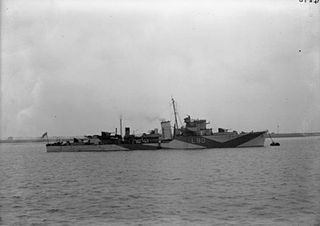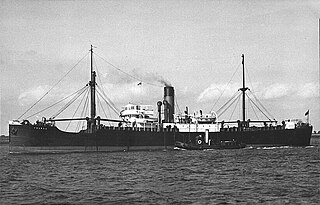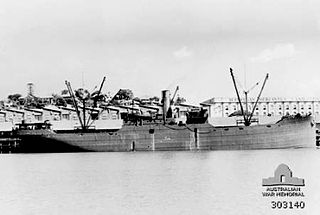
The German auxiliary cruiser Kormoran (HSK-8) was a Kriegsmarine merchant raider of World War II. Originally the merchant vessel Steiermark ("Styria"), the ship was acquired by the navy following the outbreak of war for conversion into a raider. Administered under the designation Schiff 41, 'Ship 41', to the Allied navies she was known as "Raider G". The largest merchant raider operated by Germany during World War II, Kormoran ("cormorant") was responsible for the destruction of 10 merchant vessels and the capture of an 11th during her year-long career in the Atlantic and Indian oceans.

SS Ohio was an oil tanker built for The Texas Company. The ship was launched on 20 April 1940 at the Sun Shipbuilding & Drydock Co. in Chester, Pennsylvania. The United Kingdom requisitioned it to re-supply the island fortress of Malta during the Second World War.

The Japanese raiders in the Indian Ocean were those vessels used by the Imperial Japanese Navy (IJN) during the Second World War to pursue its war on Allied commerce in that theatre. Possessing a powerful fleet of warships, prior to the start of World War II, the IJN had strategically planned to fight a war of fleet actions, and as a consequence delegated few resources to raiding merchant vessels. Nevertheless, in 1940, two passenger-cargo vessels – Aikoku Maru and Hōkoku Maru – of the Osaka Shipping Line were requisitioned for conversion to armed merchant cruisers (AMC)s, in anticipation of the likely thrust southward by the Japanese. These vessels were subsequently used as merchant raiders attacking Allied commercial shipping along vital sea lanes of communication between Australia and the Middle East. Using their comprehensive armament and speed to their advantage, the raiders experienced a brief period of success. Japanese raiding in the Indian Ocean largely ceased by the end of 1942 after an action with a Dutch vessel, the Ondina and a Royal Indian Navy corvette, HMIS Bengal in which the Hōkoku Maru was sunk.
I-21 was a Japanese Type B1 submarine which saw service during World War II in the Imperial Japanese Navy. She displaced 1,950 tons and had a speed of 24 knots (44 km/h). I-21 was the most successful Japanese submarine to operate in Australian waters, participating in the attack on Sydney Harbour in 1942 and sinking 44,000 tons of Allied shipping during her two deployments off the east coast of Australia.
Vorwärts was a wolfpack of German U-boats that operated from 25 August to 26 September 1942, in the Battle of the Atlantic during World War II. They attacked several convoys, principally Convoy ON 127, sailing from Liverpool to New York, and sank fifteen ships for a total of 79,331 gross register tons (GRT), and damaged nine (81,141 GRT).

HMS Ledbury was an escort destroyer of the Hunt class Type II. The Royal Navy ordered Ledbury's construction two days after the outbreak of the Second World War and J. I. Thornycroft Ltd laid down her keel at their Southampton yard on 24 January 1940. Air raid damage to the yard delayed her construction and she did not launch until 27 September 1941. Her initial assignment was to perform escort duties between Scapa Flow and Iceland. She remained in this theatre for the first part of the war, during which time she served with the ill-fated Arctic convoy PQ 17 in June 1942, from which twenty-four ships were lost.

The SS James B. Stephens was a 7,176-ton American liberty ship in World War II. She was built by the Oregon Shipbuilding Corporation of Portland, Oregon in 1942 with the hull number 580, and operated by United States Lines, New York City and homeported in Portland. For her role of sailing in dangerous waters, she was armed with one 5in, one 3in and four 20mm guns. She was named for the founder of East Portland.

SS Alcoa Puritan was a cargo ship in the service of Alcoa Steamship Company that was torpedoed and sunk in the Gulf of Mexico during World War II.

SS Fort Lee was a T2 tanker built for the United States Maritime Commission during World War II. The ship was assigned by the War Shipping Administration for operation by the Bernuth Lembcke Co. and operated in the Atlantic and Mediterranean early in its career.
The SS Nerissa was a passenger and cargo steamer which was torpedoed and sunk on 30 April 1941 during World War II by the German submarine U-552 following 12 wartime voyages between Canada and Britain. She was the only transport carrying Canadian Army troops to be lost during World War II.

W. L. Steed was a steam tanker built in 1917–1918 by Bethlehem Shipbuilding Corporation of Quincy for Pan American Petroleum and Transport Company, with intention of transporting oil and petroleum products between Mexican and Gulf ports and the Northeast of the United States. The ship was briefly requisitioned by the US Government during World War I but returned to commercial service in early 1919. The ship was named after William L. Steed, superintendent of the Mexican Petroleum Company of California.

SS Thurso was a cargo steamship operated by Ellerman's Wilson Line. Thurso was built in 1919 by S. P. Austin & Sons in Sunderland as the War Bramble for the Shipping Controller. Measuring 2,436 gross register tons she had a speed of 9 knots. She was sold to Ellerman Lines while still building and remained with them until lost in the Second World War.
German submarine U-65 was a Type IXB U-boat of Nazi Germany's Kriegsmarine during World War II. Over the course of six war patrols between 9 April 1940 and 28 April 1941, she sank twelve ships and damaged three others for a total loss of 88,664 gross register tons (GRT).
MV Putney Hill was a cargo ship completed by William Doxford & Sons Ltd in Sunderland in 1940. She was owned by Putney Hill Steamships Co Ltd and managed by Counties Ship Management Co Ltd of London (CSM), both of which were offshoots of the Rethymnis & Kulukundis shipbroking company. Putney Hill was a sister ship of MV Tower Grange, which Doxford built in the same year for another CSM company, Tower Steamships Co Ltd.
The Torpedo Alley, or Torpedo Junction, off North Carolina, is one of the graveyards of the Atlantic Ocean, named for the high number of attacks on Allied shipping by German U-boats in World War II. Almost 400 ships were sunk, mostly during the Second Happy Time in 1942, and over 5,000 people were killed, many of whom were civilians and merchant sailors. Torpedo Alley encompassed the area surrounding the Outer Banks, including Cape Lookout and Cape Hatteras.
MV C.O. Stillman was an oil tanker that was built by a German shipyard in 1928 for a Canadian-based shipping company. A Panamanian subsidiary of Esso bought her at the end of 1936 and she was sunk by the German submarine U-68 in the Caribbean on June 4, 1942 about 41 nautical miles (76 km) southwest of Isla de Mona, Puerto Rico.
I-37, originally numbered I-49, was a Japanese Type B1 submarine in service with the Imperial Japanese Navy during World War II. Commissioned in 1943, she made three war patrols, all in the Indian Ocean, during the last of which her crew committed war crimes by massacring the survivors of the merchant ships she sank. Subsequently, converted into a kaiten manned suicide attack torpedo carrier, she was sunk during her first kaiten mission in 1944.
India Arrow was a steam tanker built in 1921 by Bethlehem Shipbuilding Corporation of Quincy for Standard Oil Co., with intention of transporting oil and petroleum products between the United States and the Far East. During the first eight years the tanker was chiefly employed in the Pacific trade, carrying cargo between Gulf ports and a variety of destinations in East Asia. In late 1920s the tanker was moved to serve intercoastal trade routes while still making occasional trips to Asia. In early 1930s she was permanently assigned to trade routes between the Gulf and the ports on the United States East Coast, where she remained for the rest of her career.
R. W. Gallagher was a steam turbine-powered tanker built in 1938 by Bethlehem Shipbuilding Corporation of Quincy for Standard Oil Company of New Jersey with intention of operating between the oil-producing ports of the southern United States and Mexico and the Northeast. The tanker spent her entire career in coastwise trade and was torpedoed and sunk on one of regular journeys in July 1942 by German submarine U-67.

SS Coast Trader was built as the cargo ship SS Holyoke Bridge in 1920 by the Submarine Boat Company in Newark, New Jersey. The Coast Trader was torpedoed and sank 35 miles (56 km) south west of Cape Flattery, off the Strait of Juan de Fuca in U.S. state of Washington by the Japanese submarine I-26. Survivors were rescued by schooner Virginia I and HMCS Edmundston. She rests on the ocean floor at.









